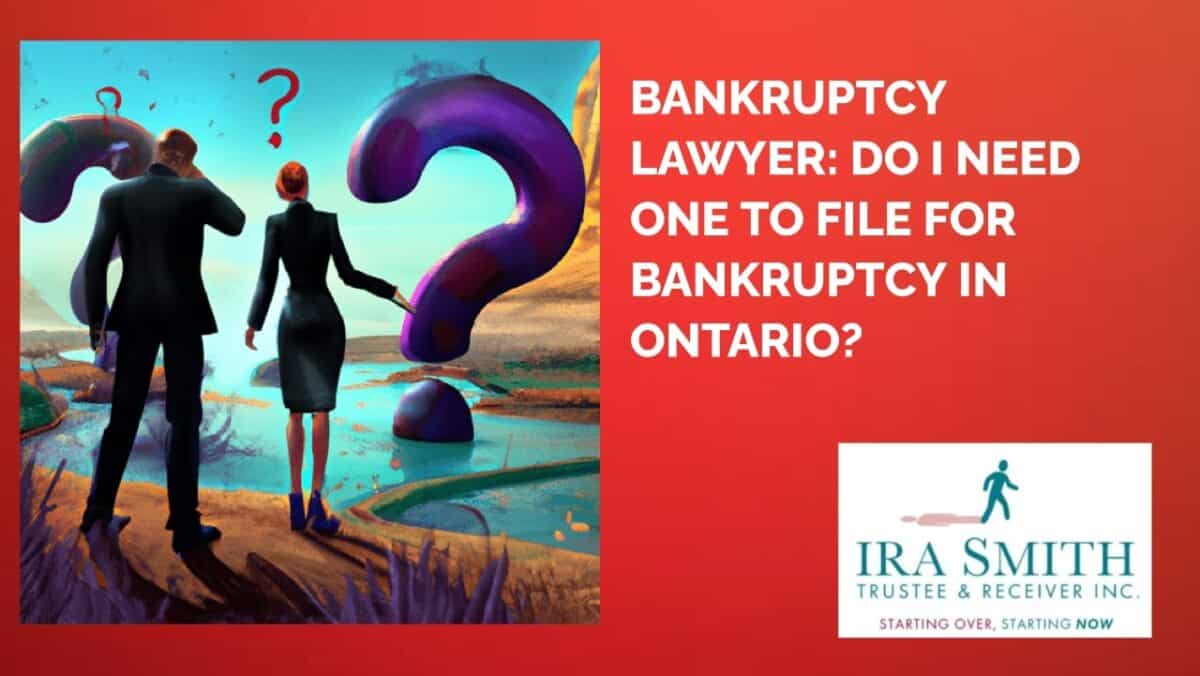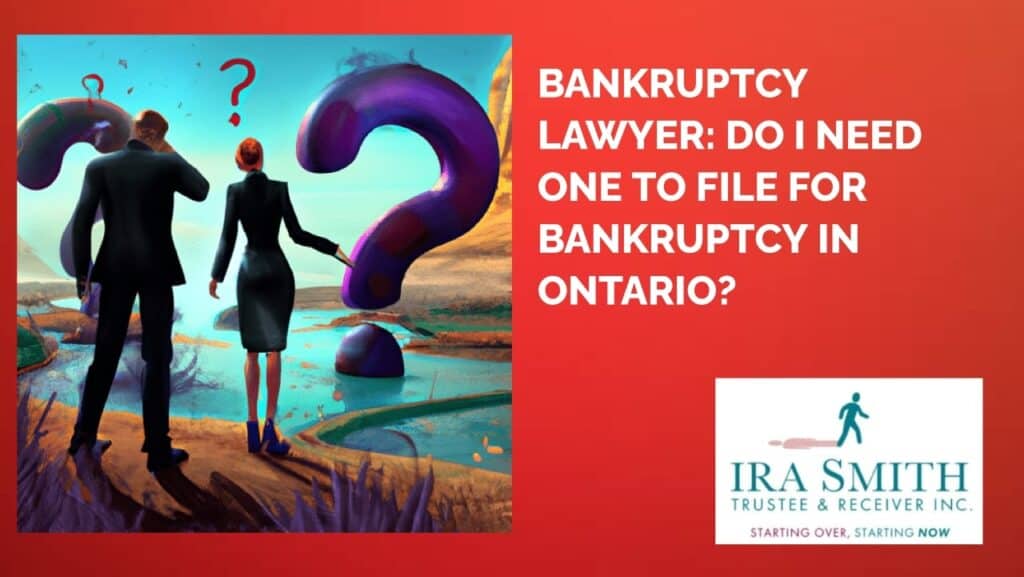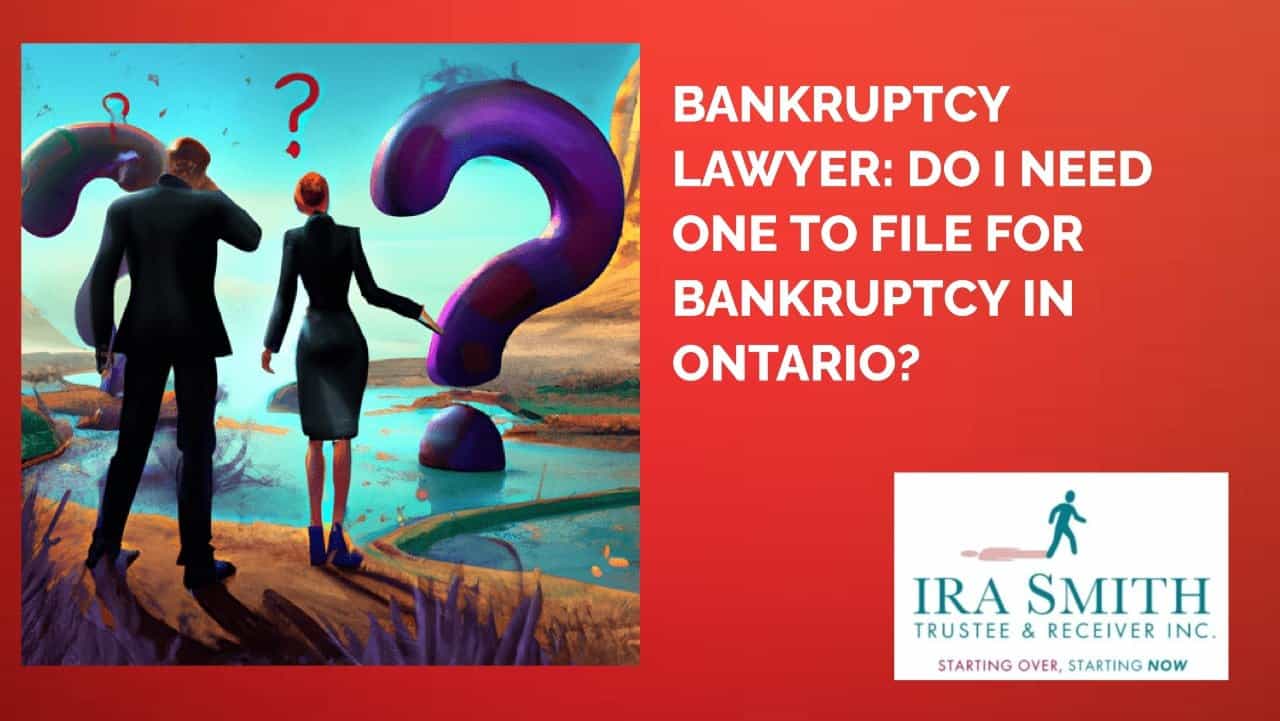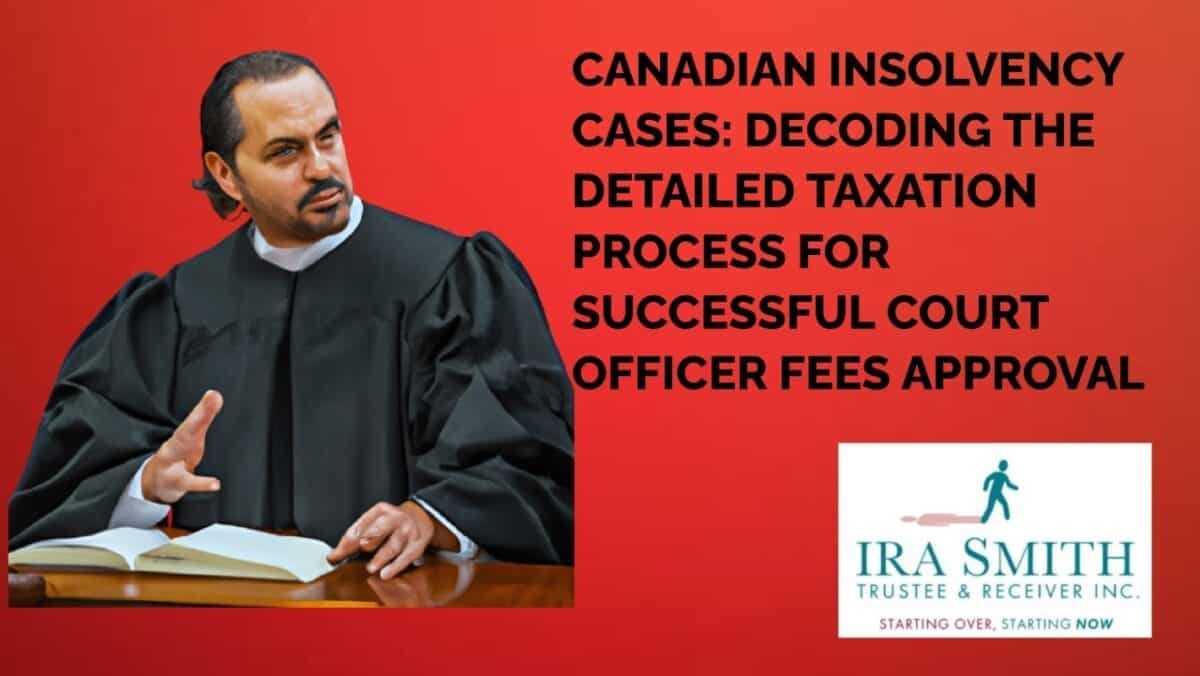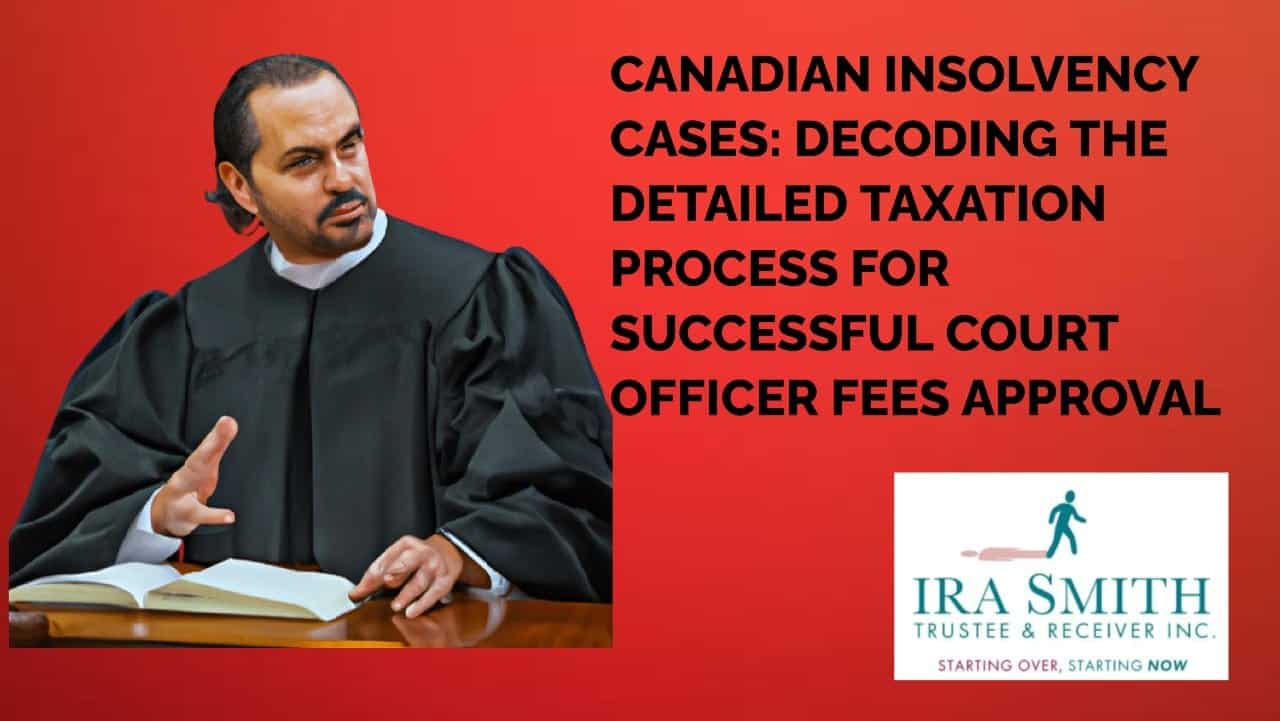Insolvency Trustee Court Order: Introduction
As a Licensed Insolvency Trustee (formerly called a trustee in bankruptcy) at Ira Smith Trustee & Receiver Inc. in the Greater Toronto Area, I meet with people and business owners every day who feel overwhelmed by debt. Many believe we only handle bankruptcies. The truth is, our role goes much deeper. We act as a bridge between financial trouble and the Canadian legal system.
From our Vaughan office at 167 Applewood Crescent, Suite 6, we help clients find a secure path through their financial challenges. One of the most powerful tools in this process is the insolvency trustee court order.
These court orders form the backbone of fairness and legality in Canadian insolvency cases. Whether you’re a small business owner looking for a way to save or safely close your business, or dealing with a multi-million-dollar corporate restructuring, court orders protect everyone involved.
Let me share a very recent Ontario court decision. In 2025, the Ontario Securities Commission (OSC) took action against Cacoeli Asset Management and related entities (Cacoeli). This case shows exactly how an insolvency trustee court order can stop improper conduct and protect investors.
In this post, I’ll explain:
- What happened in the Cacoeli case and why it matters
- How the court decided to appoint a receiver
- What a Licensed Insolvency Trustee does under a court order
- When you need a court order in insolvency proceedings
Let’s start with the case that brought these issues to light.
The Superior Court’s Insolvency Trustee Court Order Appointing the Receiver
In the recent Ontario court case of, Ontario Securities Commission v. Cacoeli Asset Management, 2025 ONSC 3012, the OSC asked the Ontario Superior Court of Justice for urgent help. They wanted an insolvency trustee court order to take control of the Cacoeli assets before their investigation was even finished. This is a serious step that requires strong reasons.
The Problem: Misused Investor Money
The OSC found that Cacoeli had raised at least $13 million from about 53 investors. Each investor thought their money was going to buy and manage a specific property. Different limited partnerships were created for each unique property.
However, the investigation revealed something troubling. Money meant for one property was allegedly being moved to support completely different properties. This is called “fund diversion.”
Investors who thought their money was buying Property A discovered it might have been used for Properties B, C, or D instead.
What Standard of Proof Was Needed?
Cacoeli’s lawyers argued that appointing a receiver is extremely serious. It takes away the company’s control over its own business. They said the OSC needed to prove a “strong prima facie case” – meaning very strong evidence that laws were broken.
Justice Steele disagreed. She confirmed that for protective orders under Ontario’s Securities Act, the OSC only needs to show “serious concern that there have been possible breaches.”
Why does this matter? It means courts can act quickly to protect investors. They don’t have to wait months or years for a full trial when people’s money is at risk.
Reading the Partnership Agreements
Cacoeli argued that their partnership agreements allowed them to move money around. They pointed to clauses that gave the General Partner power to “invest funds” and “engage in any transaction with affiliates.”
Justice Steele carefully read the agreements. She found that the “Purpose” section was crystal clear. Each partnership existed for one specific reason: to acquire and manage that particular property only.
The broad powers mentioned elsewhere in the agreement could only be used to support that specific purpose. They couldn’t be used to break the fundamental promise made to investors.
This finding confirmed that the fund diversion was serious and possibly illegal.
Why Include All Properties Under One Receiver?
Certain secured creditors held mortgages on specific Cacoeli properties. Some of them asked the court to exclude their properties from the receivership. They wanted to seize and sell those properties themselves.
Justice Steele said no. She ordered the insolvency trustee court order to cover all Cacoeli properties and companies.
Why? Excluding properties would create chaos:
- Different creditors would fight over different assets
- Multiple court cases would overlap and contradict each other
- Costs would skyrocket
- Small creditors would get nothing
Appointing one Licensed Insolvency Trustee as the court-appointed receiver guaranteed central oversight, coordination, and fairness for everyone.
Insolvency Trustee Court Order: The Court of Appeal Upholds Investor Protection
Cacoeli appealed Justice Steele’s decision. The case went to the Court of Appeal for Ontario. A panel of three justices – Hourigan, Zarnett, and Pomerance – reviewed the lower court decision in Ontario Securities Commission v. Cacoeli Asset Management Inc., 2025 ONCA 654 (CanLII).
The Main Argument on Appeal
Cacoeli made the same argument again. They insisted that appointing a receiver was so powerful that courts should require the higher “strong prima facie case” standard of proof.
The Court of Appeal’s Strong Response
The Court of Appeal rejected this argument completely. Their reasoning matters for anyone dealing with financial regulation:
- Public protection comes first: Requiring a high standard of proof would “impede the public protection mandate of the OSC”
- Early action is essential: A high standard would make it “impossible for the OSC to obtain receivership at the early stages of an investigation when the facts are not fully known.”
This is a clear message from Ontario’s highest court: when protecting the public is the priority, courts will allow regulators to act fast using an insolvency trustee court order – even before every detail is fully investigated.
The receivership order acts as a protective shield, not a final punishment.
The Final Decision
The Court of Appeal found “no question that the OSC has established a serious concern” about possible legal breaches.
The appeal was dismissed. The original insolvency trustee court order appointing the receiver remained in force.
Cacoeli was ordered to pay the OSC $15,000 for the costs of the appeal.
The Foundational Role of a Licensed Insolvency Trustee in Canada
Who Is a Licensed Insolvency Trustee?
A Licensed Insolvency Trustee (LIT) is the only professional in Canada authorized to administer bankruptcies and consumer proposals. In addition, only LITs can act as a receiver, be it private or court-appointed under an insolvency trustee court order.
We are not lawyers. We are officers of the court.
To become an LIT, you must:
- Complete rigorous education requirements
- Gain practical experience in the field
- Pass demanding written and oral examinations
- Demonstrate expertise in financial assessment, accounting, and insolvency law
This high standard allows us to act as impartial administrators of insolvency estates. Think of us as neutral referees. Our job is to balance the rights of:
- The debtor (the person or company owing money)
- The creditors (the people or companies owed money)
The Law That Guides Everything We Do
The first piece of legislation that covers every action a Licensed Insolvency Trustee takes is the federal law: the Bankruptcy and Insolvency Act Canada (BIA).
The BIA is the ultimate authority for virtually all consumer and corporate insolvency proceedings in Canada. It:
- Lays out the rules for debt relief
- Sets the framework for proposals (which help restructure debt)
- Defines the powers and duties of trustees
Very large corporate restructurings are usually done under a different federal law, the Companies’ Creditors Arrangement Act (CCAA).
The BIA and CCAA are our playbooks. The courts are the referees who make the final calls. Provincial laws also apply, but the federal BIA governs all Licensed Insolvency Trustees.
Federal Oversight: The Office of the Superintendent of Bankruptcy
Unlike most private professionals, Licensed Insolvency Trustees are constantly supervised by a federal regulator: the Office of the Superintendent of Bankruptcy Canada (OSB).
The OSB’s job is to ensure that Canada’s insolvency system is fair, efficient, and that trustees perform their duties with integrity.
This creates two layers of oversight:
- The OSB (administrative supervision)
- The Courts (judicial supervision)
This dual oversight gives the public and creditors confidence in the system. We must report all significant actions to the OSB. For many major decisions, we seek court approval through an insolvency trustee court order.
Our Core Responsibilities
Whether helping an individual consumer get a financial fresh start through a personal insolvency process or managing a complex corporate wind-down, our core responsibilities stay the same:
Secure Assets: Take possession and control of all assets belonging to the debtor (subject to provincial exemptions for individuals and the rights of trust claimants and secured creditors)
Investigate Financial Affairs: Examine the debtor’s finances, including transactions before the insolvency filing, to ensure fairness
Realize Value: Sell assets in a way that maximizes returns for creditors
Distribute Funds: Distribute money collected to creditors according to the priority rules in the BIA and/or as approved by the court through an insolvency trustee court order
Report: Provide detailed financial reports to creditors, the OSB, and the court
Understanding the Necessity of an Insolvency Trustee Court Order in Insolvency Proceedings
What Is an Insolvency Trustee Court Order?
A court order is a written ruling by a judge that must be followed. In insolvency, an insolvency trustee court order is an official directive that either:
- Grants the Licensed Insolvency Trustee specific powers, or
- Approves a significant decision or action
In the Cacoeli case, the Ontario Superior Court of Justice issued an insolvency trustee court order appointing a receiver. This order gave the receiver legal authority to seize control over all assets and properties of the Cacoeli companies.
Why Court Involvement Is Essential
Courts aren’t involved just to follow bureaucratic procedure. They serve two critical purposes:
Neutrality and Impartiality: Insolvency creates conflict. A judge provides a neutral, binding decision that everyone must respect. This ensures no single party unfairly benefits.
Legal Compliance: By reviewing the Trustee’s requests and issuing an order, the court confirms that proposed actions follow the BIA and other relevant laws strictly.
What Requires Court Approval?
Not every action a Licensed Insolvency Trustee takes requires a judge’s approval. The insolvency trustee court order appointing the receiver gives certain discretionary powers, such as handling routine matters, including administrative disbursements.
However, any major decision that impacts the fundamental rights of debtors or creditors must be sanctioned by an insolvency trustee court order. This creates a clear line between day-to-day administration and actions requiring judicial authority.
Key Scenarios Requiring a Licensed Insolvency Trustee to Obtain an Insolvency Trustee Court Order
Many actions taken by a Licensed Insolvency Trustee in a court-supervised receivership require court permission through an insolvency trustee court order. Here are the most common situations:
Approval of Trustee Fees and Administrative Costs
Our fees are strictly regulated through a process called “taxation.” The ultimate fees and costs must be approved by the court through an insolvency trustee court order.
This is a critical check to ensure the estate isn’t being overcharged. It protects creditors from excessive fees eating into their recovery.
Authorizing Unusual or Complex Transactions and Asset Sales
A key duty of a Licensed Insolvency Trustee is to liquidate (sell) assets. However, court approval is required when the transaction is:
Unusual: Selling a non-standard asset or unique piece of real estate
Complex: Selling an entire business as a “going concern” (a live business that continues operating)
Controversial: When one or more stakeholders object to the sale price or terms
In these cases, the Trustee must provide sufficient evidence to a judge for an insolvency trustee court order to approve the transaction.
Resolving Disputes Among Stakeholders
The Trustee may face disputes such as:
- A party claiming ownership of an asset under the receiver’s control
- A dispute over the validity or priority of different security interests
- Creditors disagreeing about distribution
When these disputes can’t be settled through negotiation, the Trustee brings a motion to court. A judge issues an insolvency trustee court order that settles the matter legally and definitively.
In the Cacoeli case, secured creditors wanted their properties excluded from the receivership. Justice Steele rejected this request. She stated the receivership must cover all properties to prevent chaos among creditors. This is a prime example of the court resolving a major stakeholder dispute.
Approving Debtor Proposals and Restructuring Plans
The goal of a business proposal under a BIA Division I Proposal or major corporate restructuring under the CCAA is to financially restructure the company to save it and as many jobs as possible.
A significant insolvency trustee court order is always required for final approval of a Division I restructuring proposal or restructuring plan. The court confirms that the plan is fair, reasonable, viable and calculated for the general benefit of all creditors.
Modifying, Annulling, or Terminating Insolvency Proceedings
Sometimes a debtor’s situation changes. They may need to alter their original plan based on changed circumstances. Or the Trustee may discover an issue that warrants ending the insolvency proceeding entirely, as the original plan is no longer viable.
A judge must review the facts and issue an insolvency trustee court order to modify, annul, or terminate the proceeding.
Addressing Trustee Liability or Allegations of Misconduct
If any stakeholder alleges that a LIT has breached their duties or acted improperly, the matter goes before a judge.
The court must issue an order to investigate the claim. If necessary, the court can order compensation or disciplinary action against the Trustee. This ensures absolute accountability.
The Far-Reaching Significance of Judicial Oversight in Insolvency
Protecting the Interests of All Parties
Judicial oversight is about trust. By demanding an insolvency trustee court order for critical actions, the system provides comfort to all parties:
Debtors know the process is being handled legally
Creditors know assets can’t be sold cheaply or favour one creditor over another
The Public knows the integrity of capital markets is being enforced, as the Court of Appeal confirmed in the Cacoeli case
Ensuring Transparency, Accountability, and Due Process
Every court motion becomes part of a public record. This transparency ensures every stakeholder can review the trustee’s actions.
The process also provides due process – the right to be heard. Any party can attend a hearing and object to a proposed action.
Upholding Public Confidence in the Canadian Insolvency System
Canada’s entire economy relies on:
- The ability of businesses to take risks
- The ability of creditors to enforce their rights
According to Industry Canada’s publication “Fresh Start: A Review of Canada’s Insolvency Laws“:
Insolvency legislation is a key component of Canada’s marketplace framework legislation that governs commercial relationships for both consumers and businesses. Certain and reliable rules provide security for investors and lenders that, in turn, influences the cost and availability of credit in the Canadian marketplace.
When the system fails, the court restores order. They are the clear, final legal instrument that upholds the integrity of the process and ensures public faith in financial markets and debt restructuring.
The Ultimate Framework for All Decisions
Regardless of the unique facts of any case, every judicial decision is rooted in federal and provincial law. Judges interpret the law to deliver their orders, making it the ultimate framework for every action taken by a Licensed Insolvency Trustee.
Consequences of Acting Without a Necessary Insolvency Trustee Court Order
Potential Ramifications for the Licensed Insolvency Trustee
A trustee who ignores the need for an insolvency trustee court order faces serious consequences:
Personal Liability: The trustee could be held personally responsible for any financial loss to the estate caused by unauthorized action
Disciplinary Action: The court and the OSB could impose sanctions, fines, or, in severe cases, the OSB could revoke the LIT’s license
Voided Actions: The action itself (such as an asset sale) could be reversed or voided by a subsequent court decision, creating chaos and cost
Adverse Impacts on the Insolvency Estate and Stakeholders
When a Licensed Insolvency Trustee acts outside the BIA or without proper authorization, the entire estate suffers:
Increased Costs: The estate incurs significant costs fighting legal challenges and correcting unauthorized actions
Delayed Proceedings: Disputes and legal challenges drag out the process, delaying final distribution of funds to creditors
Loss of Confidence: Creditors and debtors lose faith in the insolvency administration, leading to an unnecessarily hostile environment
Section 37 of the BIA provides that any person aggrieved by any act or decision of a Licensed Insolvency Trustee can apply to court to reverse or alter that act or decision. The court also has the authority to sanction the trustee.
Frequently Asked Questions: Insolvency Trustee Court Order
What is a Licensed Insolvency Trustee?
A Licensed Insolvency Trustee is the only professional in Canada who can legally administer receiverships, bankruptcies and consumer proposals. We used to be called trustee in bankruptcy, but the name changed to better reflect our broader role.
Think of us as a bridge between your financial troubles and the Canadian legal system. We’re officers of the court, which means we have a legal duty to be fair and impartial.
Only Licensed Insolvency Trustees can act as receivers, whether privately appointed or through an insolvency trustee court order.
To become an LIT, you must:
- Complete rigorous education requirements
- Gain practical experience in insolvency work
- Pass demanding national examinations
- Demonstrate expertise in insolvency law, accounting, and financial assessment
This ensures that every LIT has the knowledge and skills to handle complex financial situations fairly.
What does a Licensed Insolvency Trustee actually do?
Whether we’re helping someone with personal debt or managing a complex corporate restructuring or bankruptcy, our core responsibilities stay the same:
Secure Assets: We take control of all assets belonging to the debtor. This protects them from being hidden or sold improperly. (Some assets are exempt, and trust claimants and secured creditors keep their rights.)
Investigate Financial Affairs: We carefully examine the debtor’s financial transactions made before filing for insolvency.
Realize Value: We sell assets in a way that gets the best possible return for creditors. This might mean selling items individually or selling a business as a going concern.
Distribute Funds: We distribute the money we collect to creditors following the strict priority rules in the Bankruptcy and Insolvency Act. Sometimes, an insolvency trustee court order determines the distribution.
Report: We provide detailed financial reports to the court, creditors, and the Office of the Superintendent of Bankruptcy. Transparency is essential.
What law governs Licensed Insolvency Trustees in Canada?
The primary law that guides almost everything we do is the federal Bankruptcy and Insolvency Act. This is Canada’s main insolvency legislation.
The BIA covers:
- Rules for debt relief and bankruptcy
- The framework for consumer proposals and corporate proposals
- The powers and duties of Licensed Insolvency Trustees
- Priority rules for paying creditors
- When court orders are required
For very large corporate restructurings (typically companies with debts over $5 million), the federal Companies’ Creditors Arrangement Act often applies instead. The CCAA allows for more flexible restructuring options.
Both laws work together with provincial legislation to create Canada’s comprehensive insolvency system.
Who oversees Licensed Insolvency Trustees?
Licensed Insolvency Trustees operate under two layers of oversight. This dual supervision ensures the system works fairly:
The Courts: Provide judicial supervision and make final decisions on major actions. Courts issue insolvency trustee court orders that authorize significant steps in the process.
The Office of the Superintendent of Bankruptcy Canada: This federal regulator provides administrative supervision. The OSB ensures:
- Canada’s insolvency system remains fair and efficient
- Trustees perform their duties with integrity
- Trustees follow all rules and regulations
- Any complaints against trustees are investigated
This two-level oversight gives the public, debtors, and creditors confidence that the process will be handled properly.
What is an insolvency trustee court order?
An insolvency trustee court order is a written ruling issued by a judge that must be followed. It’s a legally binding document.
In insolvency cases, these court orders serve two main purposes:
- Grant the Licensed Insolvency Trustee specific legal powers
- Approve a significant decision or action that the LIT plans to take
These orders form the backbone of fairness and legality in Canadian insolvency cases. They ensure that major decisions have judicial approval and oversight.
For example, when a receiver is appointed (like in the Cacoeli case discussed in our blog), the insolvency trustee court order gives that receiver the legal authority to take control of assets and manage the insolvency process.
Why do courts get involved in insolvency proceedings?
Courts aren’t just following bureaucratic procedure. They serve two critical purposes in insolvency:
Ensuring Neutrality and Impartiality: Insolvency creates conflict. Creditors want their money. Debtors need protection. The judge provides a neutral, binding decision that everyone must respect. This prevents any single party from benefiting unfairly at the expense of others.
Confirming Legal Compliance: Before issuing an insolvency trustee court order, the court reviews the Applicant’s request carefully. This confirms that the proposed actions strictly follow the BIA and other relevant laws. If something doesn’t comply with the law, the judge won’t approve it.
This judicial oversight protects everyone’s rights and maintains public confidence in Canada’s insolvency system.
When does a Licensed Insolvency Trustee need a court order?
Not every action requires an insolvency trustee court order. We have discretionary powers for routine administrative matters – like paying regular administrative expenses or communicating with creditors.
However, any major decision that impacts the fundamental rights of creditors or debtors must be sanctioned by a court order. Here are the most common scenarios:
Approval of Fees and Costs: Our fees and administrative costs must be approved by the court through a process called “taxation.” This protects creditors from excessive charges eating into their recovery.
Authorizing Complex Transactions: Court approval is required for asset sales that are:
- Unusual (non-standard assets or unique properties)
- Complex (selling an entire business as a going concern)
- Controversial (stakeholders object to the sale price or terms)
Resolving Disputes: When disputes arise – such as someone claiming ownership of an asset, or secured creditors disagreeing about distribution priorities – we bring a motion to court. The judge issues an order that settles the matter legally and definitively.
Approving Restructuring Plans: Final approval of a BIA Division I restructuring proposal or a CCAA corporate restructuring plan always requires a significant insolvency trustee court order. The court must confirm that the plan is fair, reasonable, and has a realistic chance of success.
Modifying Proceedings: If circumstances change and the insolvency proceedings need to be modified, annulled, or otherwise terminated, a court order is required.
Addressing Trustee Issues: If anyone alleges the LIT has breached their duties, the matter goes before a judge who can investigate and order appropriate remedies.
What happens if a trustee acts without getting a required court order?
Ignoring the requirement for an insolvency trustee court order leads to serious consequences for the Licensed Insolvency Trustee:
Personal Liability: The LIT may be held personally responsible for any financial loss to the estate caused by the unauthorized action. This means paying out of their own pocket.
Disciplinary Action: The court or the OSB can impose:
- Sanctions
- Significant fines
- Suspension from practice
- In severe cases, complete revocation of the LIT’s license
Voided Actions: The unauthorized action itself – such as an improper asset sale – could be reversed or voided by a subsequent court decision. This creates chaos and additional costs.
Negative Impact on Everyone: Unauthorized actions harm the entire insolvency estate:
- Increased legal costs
- Delayed proceedings
- Loss of creditor confidence
- Potential loss of asset value
Section 37 of the BIA specifically allows any person who is aggrieved by an LIT’s decision to apply to court to reverse or alter that decision. The court has full authority to sanction the trustee.
What standard of proof is needed to appoint a receiver in regulatory cases?
This is one of the most important takeaways from the Cacoeli case about insolvency trustee court orders.
When a regulator like the Ontario Securities Commission asks the court for urgent protection, they only need to show “serious concern that there have been possible breaches.”
This is a lower standard than criminal cases or even most civil cases. The court doesn’t need:
- Absolute proof of fraud
- Complete evidence
- A finished investigation
The Court of Appeal for Ontario specifically rejected the argument that regulators must meet a higher “strong prima facie case” standard.
Why does this matter?
This lower standard allows courts and regulators to act quickly through an insolvency trustee court order to:
- Protect investors from ongoing harm
- Freeze assets before they disappear
- Stop improper conduct immediately
- Preserve evidence
The insolvency trustee court order appointing a receiver acts as a protective shield, not a final punishment. Full investigations and trials can happen later, but the immediate protection comes first.
Why did the Cacoeli court order cover all properties, even those with secured creditors?
In the Cacoeli case, some secured creditors held mortgages on specific properties. They asked the court to exclude their properties from the receivership so they could seize and sell those properties themselves.
Justice Steele refused this request. The insolvency trustee court order covered all Cacoeli assets and properties without exception.
The Court of Appeal upheld this decision. Here’s why centralized control under one Licensed Insolvency Trustee as receiver was essential:
Prevents Creditor Chaos: If different creditors could seize different assets, they would fight over everything. The process would become a free-for-all with no coordination.
Avoids Multiple Court Cases: Excluding properties would lead to numerous separate legal proceedings, all overlapping and potentially contradicting each other.
Controls Costs: Multiple proceedings mean multiplied legal costs. A single insolvency trustee court order with one receiver keeps costs manageable.
Protects Small Creditors: When secured creditors grab assets first, unsecured creditors and small suppliers are not given a forum. Centralized control ensures everyone is treated fairly according to their legal priority.
Enables Efficient Administration: One receiver can see the whole picture, make coordinated decisions, and maximize value for all stakeholders.
This principle applies to most complex insolvency cases: centralized control through an insolvency trustee court order produces better outcomes than fragmented, competing proceedings.
Insolvency Trustee Court Order Final Thoughts: The Licensed Insolvency Trustee’s Role in a Regulatory Receivership
The insolvency trustee court order is an instrument of authority, protection, and fairness. As Licensed Insolvency Trustees, our job – whether in a standard bankruptcy, a financial restructuring or a specialized receivership like the Cacoeli case – is to impose order and protect stakeholders.
The Cacoeli decisions confirmed two critical points:
Lower Standard for Protection: Courts won’t wait for proof of fraud to a certainty. The “serious concern” standard is enough to appoint an LIT as a receiver quickly. This is essential to freeze assets and prevent further investor harm.
Centralized Control Is Key: The court agreed that the entire portfolio of assets must be placed under one receiver’s control – even properties secured by third parties. This centralized approach, ordered by the court, prevents a fragmented, costly, and unfair outcome for all stakeholders.
Need Help With Debt or Insolvency Issues?
If you’re facing financial challenges – whether personal or business-related – understanding the role of an insolvency trustee court order is just the beginning. At Ira Smith Trustee & Receiver Inc., we’ve helped many individuals and businesses in the Greater Toronto Area find their path to financial recovery.
From our Vaughan office, we provide:
- Free, confidential consultations
- Expert guidance on bankruptcy alternatives
- Consumer proposals that can reduce your debt
- Corporate restructuring solutions
- Court-supervised receiverships
Contact us today to discuss your situation. Let us help you understand your options and find the best solution for your financial future.
Brandon Smith, Licensed Insolvency Trustee
Senior Vice-President
Ira Smith Trustee & Receiver Inc.
167 Applewood Crescent, Suite 6
Vaughan, Ontario
Greater Toronto Area
The information provided in this blog is intended for educational purposes only. It is not intended to constitute legal, financial, or professional advice. Readers are encouraged to seek professional advice regarding their specific situations. The content should not be relied upon as a substitute for professional guidance or consultation. The author, Ira Smith Trustee & Receiver Inc., and any contributors do not assume any liability for any loss or damage.
Brandon Smith is a Licensed Insolvency Trustee and Senior Vice-President at Ira Smith Trustee & Receiver Inc., serving individuals and businesses throughout the Greater Toronto Area. With years of experience in insolvency cases, including financial restructuring, Brandon helps clients navigate complex financial challenges and find sustainable solutions, Starting Over Starting Now.





